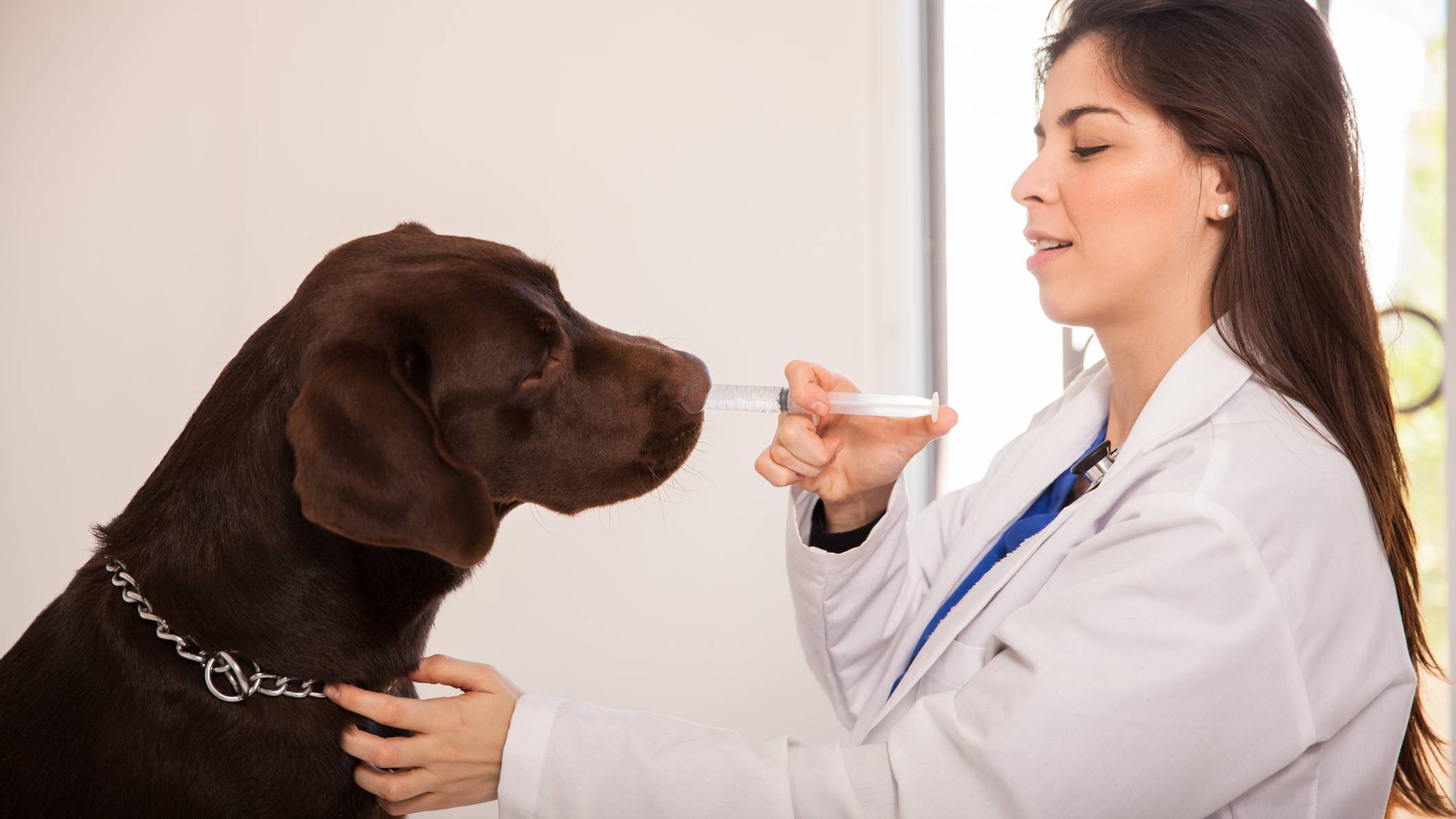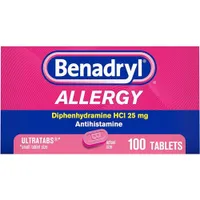Benadryl for dogs: Vet’s guide to dosage, uses and side effects
It is frequently taken by humans to combat allergies, but is Benadryl for dogs too? A vet gives their expert advice

If your pooch suffers from bad allergies, you may be wondering could Benadryl for dogs be helpful in easing their symptoms?
Used commonly in both human and veterinary medicine, in dogs, Benadryl can be given for a variety of reasons; from mild allergies to certain tumors to life-threatening allergic reactions (in which case, it helps to have pet insurance on hand).
Benadryl has only been approved by the FDA for human use, however, so it is important to make several considerations before giving it to your dog. Read on to learn more about this medication, its uses in dogs, and the risks associated with it.
What is Benadryl?
Benadryl is an antihistamine that contains diphenhydramine as its active ingredient. Antihistamines block histamine receptors in the body to alleviate allergy symptoms such as itchiness, sneezing, and rashes. Benadryl comes in several forms, including tablets, capsules, oral liquids, and injections.
Because dogs metabolize drugs differently than humans, you should always consult with your vet before giving your dog Benadryl or other human medications, such as Pepto Bismol.
What is Benadryl used for in dogs?
Benadryl is used commonly in dogs for several reasons, including:
Mild to moderate environmental allergies
Benadryl can sometimes help with symptoms of common environmental or seasonal allergies in dogs, including itchy red skin, hives, and sneezing.
Get the best advice, tips and top tech for your beloved Pets
Many dogs with skin allergies require stronger prescription medications that regulate or suppress the immune system to control their symptoms. Some may also need antibiotics like Clavamox if they have secondary bacterial skin infections.
Allergic reactions
Acute allergic reactions to insect bites or stings, plants, pollen, or other allergens can be treated with Benadryl in dogs.
Dogs experiencing severe reactions with symptoms of life-threatening anaphylaxis (i.e. facial swelling, difficulty breathing, itchiness, rash) usually require additional treatment and should be taken to a vet immediately.
Motion sickness
Benadryl can prevent nausea and vomiting in dogs with motion sickness if it is given one hour before travel.
Mild sedation
Benadryl can cause drowsiness in both dogs and humans, so it is sometimes used as a mild sedative.
Pre-treatment before vaccination
Vets often recommend that Benadryl is given for two or three days before and after vaccination in dogs who have had previous vaccine reactions.
Mast cell tumors
Mast cell tumors release histamine into the body, so vets often prescribe Benadryl to dogs with these tumors to prevent symptoms.
Once you’ve spoken to your vet, if Benadryl is indicated for your dog, it is easy to get hold of online.
Some 'allergy' symptoms can be due to more serious underlying health conditions. In addition, some medications can influence the effectiveness of Benadryl. You should always consult with your vet before giving Benadryl to ensure that it is safe for your dog.

What is the recommended dose of Benadryl for dogs?
According to MSD Veterinary Manual, the recommended dose of Benadryl for dogs is 2-4mg/kg (or 0.9-1.8mg/lb) given two or three times per day.
Since Benadryl is given off-label in veterinary medicine and because underlying diseases and other medications can affect the optimal dosage, the human guidelines should not be followed and dogs should be given the dose recommended by their vet.
The form of Benadryl should also be considered when determining the dose. Children’s Benadryl is considered safer than adult Benadryl, especially in small dogs, because the dose can be adjusted more carefully. Time-release capsules should be avoided because they may break down quicker in a dog’s stomach, increasing the risk of overdose.
Additionally, liquid medications are absorbed differently than pills, so a different dose may be required. The ingredients list should be examined carefully to ensure that the only active ingredient is diphenhydramine, as some formulations contain alcohol or decongestants that can be toxic to dogs.
Side effects of Benadryl in dogs
Benadryl usage comes with several possible side effects, including:
- Lethargy/drowsiness
- Dry mouth or increased salivation
- Increased heart rate
- Rapid breathing
- Urinary retention
- Vomiting
- Diarrhea
- Loss of appetite
As with all medications, dogs can be allergic to Benadryl and show symptoms such as skin rash, hives, itchiness, facial swelling, and difficulty breathing. If a dog is showing any of these signs, veterinary attention should be sought as soon as possible.
Although Benadryl is considered quite safe in dogs, overdose can occur. Signs of overdose typically appear in the first hour after Benadryl is given and include:
- Hyperactivity or severe lethargy
- Aggression or agitation
- Hypersalivation
- Rapid heart rate and respirations
- Difficulty breathing
- Seizures
Benadryl overdose can be life-threatening, so dogs showing any of these symptoms should be taken to a vet immediately.

How long will Benadryl make my dog sleepy?
Benadryl typically starts taking effect one or two hours after it is given in dogs, and its effects, including sleepiness, can last up to 24 hours. Several factors can influence this, however, such as age, dose, and underlying medical conditions. For example, the effects of Benadryl may last longer in dogs with liver or kidney disease.
Is it OK to give a dog Benadryl for anxiety?
Although some recommend Benadryl for anxiety related to travel or loud noises due to its mild sedative effect, it does not treat the root cause of anxiety.
In some pets, it may even worsen anxiety symptoms. For this reason, the underlying cause of anxiety should be targeted with behavior modification and environmental changes, which may require assistance from a veterinary behaviorist in some cases.
Considerations before giving Benadryl to dogs
Many factors can influence whether a dog will benefit from Benadryl:
Other medications
Some medications and supplements can interact with Benadryl, affecting one or both drugs’ efficacies.
These include anticholinergic drugs, anticoagulants, tricyclic antidepressants, sedatives, and some pain medications. For example, gabapentin has mild sedative effects that can worsen the drowsiness associated with Benadryl.
Other health conditions
Benadryl should be given with caution in dogs with certain health conditions as well, including heart disease, glaucoma, hyperthyroidism, hypertension, and seizures.
It should also be avoided in young puppies and dogs who are pregnant or lactating unless specifically recommended by a vet. It should not be given to dogs with known allergies to Benadryl or other antihistamines.
It is important to consult with a vet before giving your dog Benadryl so that they can obtain a full medical history and perform a thorough physical examination with relevant diagnostic tests to determine that it will be safe and effective.
Read next: Helping a dog with seasonal allergies
Dr. Diana Hasler graduated with distinction from the University of Edinburgh Royal (Dick) School of Veterinary Studies in 2018. She has experience working as a small animal veterinarian in general practice, where she has treated many dogs, cats, rabbits, and rodents. She has also recently branched out into the field of medical communications, doing freelance work as a medical editor and writer. Dr. Hasler has been Postdoctoral Research Fellow at Michigan Medicine since 2023, where she is a Laboratory Animal Medicine Resident.


